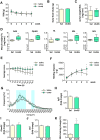Both ghrelin deletion and unacylated ghrelin overexpression preserve muscles in aging mice
- PMID: 32712599
- PMCID: PMC7425472
- DOI: 10.18632/aging.103802
Both ghrelin deletion and unacylated ghrelin overexpression preserve muscles in aging mice
Abstract
Sarcopenia, the decline in muscle mass and functionality during aging, might arise from age-associated endocrine dysfunction. Ghrelin is a hormone circulating in both acylated (AG) and unacylated (UnAG) forms with anti-atrophic activity on skeletal muscle. Here, we show that not only lifelong overexpression of UnAG (Tg) in mice, but also the deletion of ghrelin gene (Ghrl KO) attenuated the age-associated muscle atrophy and functionality decline, as well as systemic inflammation. Yet, the aging of Tg and Ghrl KO mice occurs with different dynamics: while old Tg mice seem to preserve the characteristics of young animals, Ghrl KO mice features deteriorate with aging. However, young Ghrl KO mice show more favorable traits compared to WT animals that result, on the whole, in better performances in aged Ghrl KO animals. Treatment with pharmacological doses of UnAG improved muscle performance in old mice without modifying the feeding behavior, body weight, and adipose tissue mass. The antiatrophic effect on muscle mass did not correlate with modifications of protein catabolism. However, UnAG treatment induced a strong shift towards oxidative metabolism in muscle. Altogether, these data confirmed and expanded some of the previously reported findings and advocate for the design of UnAG analogs to treat sarcopenia.
Keywords: growth hormone secretagogue receptor; inflammaging; sarcobesity; sarcopenia; skeletal muscle atrophy.
Conflict of interest statement
Figures







References
Publication types
MeSH terms
Substances
LinkOut - more resources
Full Text Sources
Medical
Research Materials
Miscellaneous

